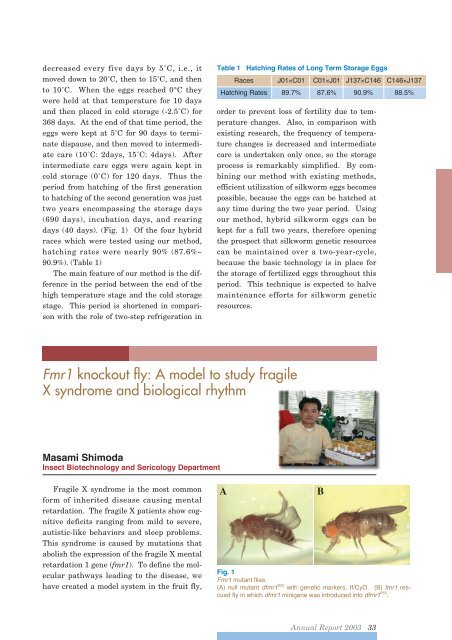You also want an ePaper? Increase the reach of your titles
YUMPU automatically turns print PDFs into web optimized ePapers that Google loves.
decreased every five days by 5˚C, i.e., itmoved down to 20˚C, then to 15˚C, and thento 10˚C. When the eggs reached 0°C theywere held at that temperature for 10 daysand then placed in cold storage (-2.5˚C) for368 days. At the end of that time period, theeggs were kept at 5˚C for 90 days to terminatedispause, and then moved to intermediatecare (10˚C: 2days, 15˚C: 4days). Afterintermediate care eggs were again kept incold storage (0˚C) for 120 days. Thus theperiod from hatching of the first generationto hatching of the second generation was justtwo years encompassing the storage days(690 days), incubation days, and rearingdays (40 days). (Fig. 1) Of the four hybridraces which were tested using our method,hatching rates were nearly 90% (87.6%~90.9%). (Table 1)The main feature of our method is the differencein the period between the end of thehigh temperature stage and the cold storagestage. This period is shortened in comparisonwith the role of two-step refrigeration inTable 1 Hatching Rates of Long Term Storage EggsRaces J01×C01 C01×J01 J137×C146 C146×J137Hatching Rates 89.7% 87.6% 90.9% 88.5%order to prevent loss of fertility due to temperaturechanges. Also, in comparison withexisting research, the frequency of temperaturechanges is decreased and intermediatecare is undertaken only once, so the storageprocess is remarkably simplified. By combiningour method with existing methods,efficient utilization of silkworm eggs becomespossible, because the eggs can be hatched atany time during the two year period. Usingour method, hybrid silkworm eggs can bekept for a full two years, therefore openingthe prospect that silkworm genetic resourcescan be maintained over a two-year-cycle,because the basic technology is in place forthe storage of fertilized eggs throughout thisperiod. This technique is expected to halvemaintenance efforts for silkworm geneticresources.Fmr1 knockout fly: A model to study fragileX syndrome and biological rhythmMasami ShimodaInsect Biotechnology and Sericology DepartmentFragile X syndrome is the most commonform of inherited disease causing mentalretardation. The fragile X patients show cognitivedeficits ranging from mild to severe,autistic-like behaviors and sleep problems.This syndrome is caused by mutations thatabolish the expression of the fragile X mentalretardation 1 gene (fmr1). To define the molecularpathways leading to the disease, wehave created a model system in the fruit fly,AFig. 1Fmr1 mutant flies.(A) null mutant dfmr1 B55 with genetic markers, If/CyO. (B) fmr1 rescuedfly in which dfmr1 minigene was introduced into dfmr1 B55 .B<strong>Annual</strong> <strong>Report</strong> <strong>2003</strong> 33













